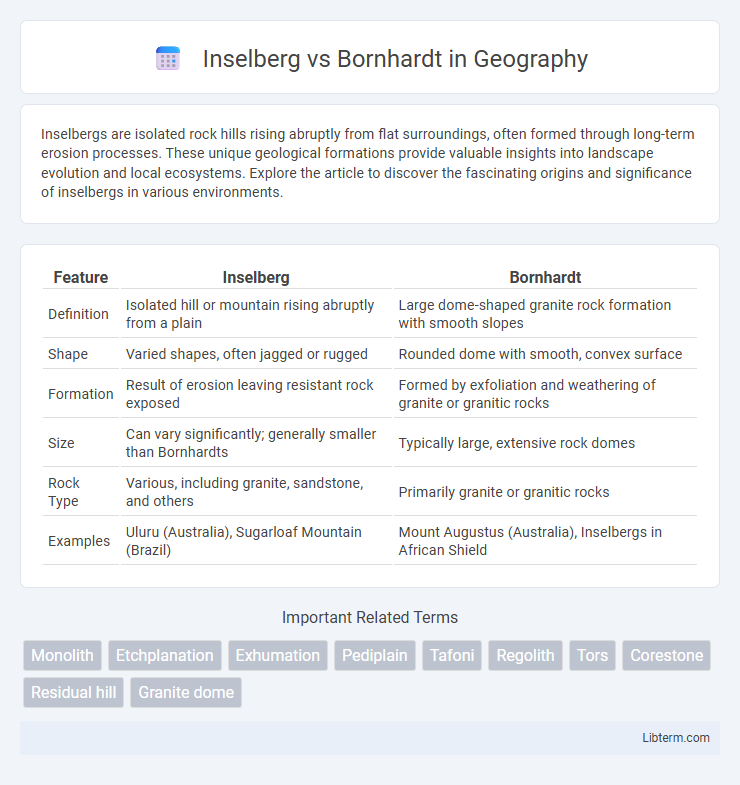Inselbergs are isolated rock hills rising abruptly from flat surroundings, often formed through long-term erosion processes. These unique geological formations provide valuable insights into landscape evolution and local ecosystems. Explore the article to discover the fascinating origins and significance of inselbergs in various environments.
Table of Comparison
| Feature | Inselberg | Bornhardt |
|---|---|---|
| Definition | Isolated hill or mountain rising abruptly from a plain | Large dome-shaped granite rock formation with smooth slopes |
| Shape | Varied shapes, often jagged or rugged | Rounded dome with smooth, convex surface |
| Formation | Result of erosion leaving resistant rock exposed | Formed by exfoliation and weathering of granite or granitic rocks |
| Size | Can vary significantly; generally smaller than Bornhardts | Typically large, extensive rock domes |
| Rock Type | Various, including granite, sandstone, and others | Primarily granite or granitic rocks |
| Examples | Uluru (Australia), Sugarloaf Mountain (Brazil) | Mount Augustus (Australia), Inselbergs in African Shield |
Introduction to Inselberg and Bornhardt
Inselbergs are isolated rock hills or mountains rising abruptly from flat plains, commonly found in arid and semi-arid regions worldwide. Bornhardts are specific types of inselbergs characterized by their smooth, dome-shaped granite formations formed through deep weathering and exfoliation processes. Both geological features exemplify landscape evolution influenced by long-term weathering and erosion, but bornhardts display a distinctive rounded morphology compared to the often more angular inselbergs.
Geological Definitions
An Inselberg is an isolated hill or mountain rising abruptly from a gently sloping or virtually level surrounding plain, typically formed by differential erosion of surrounding softer rock. A Bornhardt is a specific type of inselberg characterized by its dome-shaped, smooth surface composed mainly of massive, resistant rock such as granite or gneiss. Both geological formations illustrate weathering and erosion processes, but a Bornhardt's distinctive rounded form differentiates it from more irregular inselbergs.
Formation Processes
Inselbergs and bornhardts both form through long-term weathering and erosion, but their formation processes differ significantly. Inselbergs are isolated hills that emerge from gently sloping or nearly level plains due to differential erosion, where softer surrounding rocks erode faster than the resistant rock of the inselberg. Bornhardts form as dome-shaped, steep-sided bedrock outcrops created by the exfoliation and insolation weathering of massive, homogeneous igneous or metamorphic rocks, typically granite, resulting in a rounded summit with smooth slopes.
Distinctive Features
An Inselberg is an isolated hill or mountain rising abruptly from a plain, characterized by its steep, often jagged sides and significant relative height, while a Bornhardt is a type of rounded, dome-shaped granitic hill with smooth slopes and a more uniform curvature. Inselbergs typically exhibit more variable rock types and pronounced erosion patterns compared to the Bornhardt's consistent rock composition and exfoliation weathering. The distinctive feature of a Bornhardt lies in its convex bald surface formed primarily by sheet jointing, contrasting with the diverse and rugged morphology of an Inselberg.
Global Examples
Inselbergs and bornhardts are distinctive geological formations found worldwide, with inselbergs such as Uluru in Australia and Sugarloaf Mountain in Brazil exemplifying isolated hills rising abruptly from plains. Bornhardts, characterized by dome-shaped, granitic rock masses, are prominent in places like the Matobo Hills in Zimbabwe and the Brandberg Mountain in Namibia. These features provide critical insights into weathering processes and landscape evolution in arid and semi-arid environments globally.
Comparison of Morphology
Inselbergs are isolated, steep-sided rock hills rising abruptly from flat plains, typically exhibiting rugged and irregular shapes, while bornhardts are dome-shaped, smooth, and massive rock outcrops with a convex surface. Morphologically, inselbergs often display jagged profiles due to differential weathering and erosion, whereas bornhardts have rounded contours resulting from exfoliation and spheroidal weathering processes. The key distinction lies in the surface texture and form: inselbergs present angular and uneven features, in contrast to the uniform, bulbous morphology characteristic of bornhardts.
Role in Landscape Evolution
Inselbergs and bornhardts are prominent landforms that significantly influence landscape evolution through their resistance to weathering and erosion. Inselbergs, isolated rocky hills rising abruptly from plains, serve as indicators of prolonged weathering in stable cratonic regions, shaping surrounding sedimentation patterns. Bornhardts, characterized by their dome-shaped massive rock surfaces, contribute to landscape development by directing surface water flow and promoting differential erosion, further sculpting topography over geological time scales.
Ecological Importance
Inselbergs and bornhardts, both prominent isolated rock formations, play crucial roles in biodiversity conservation by providing unique microhabitats for specialized flora and fauna. Inselbergs often support distinct vegetation adapted to harsh conditions, while bornhardts offer stable, erosion-resistant surfaces essential for endemic species survival. Their ecological importance also includes acting as natural water catchments, contributing to localized water availability in arid landscapes.
Human Interactions and Uses
Inselbergs, often isolated rock hills found in arid regions, serve as crucial landmarks for navigation and hold cultural significance for indigenous communities who utilize their slopes for rituals and traditional practices. Bornhardts, characterized by their smooth, dome-shaped granite formations, provide stable, elevated grounds historically used for settlements, grazing, and water catchment during dry seasons. Both landforms influence local agriculture and tourism, with their unique geological features attracting hikers and researchers while offering essential resources to surrounding populations.
Conclusion: Key Differences and Similarities
Inselbergs are isolated rock hills or mountains rising abruptly from flat plains, while bornhardts are large, dome-shaped, smooth rock outcrops typically composed of resistant granite or gneiss. Both landforms result from long-term weathering and erosion processes but differ in shape and geological context; inselbergs can have varied forms, whereas bornhardts are specifically characterized by their rounded, dome-like appearance. Despite these distinctions, both features highlight the interaction between bedrock resistance and erosional forces shaping the landscape.
Inselberg Infographic

 libterm.com
libterm.com